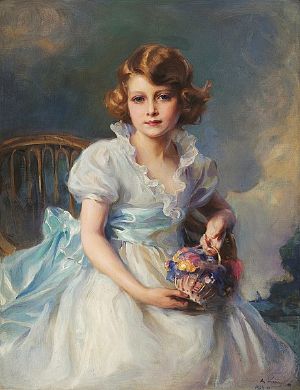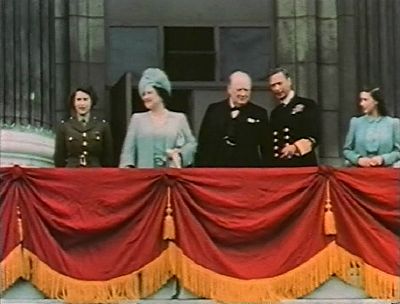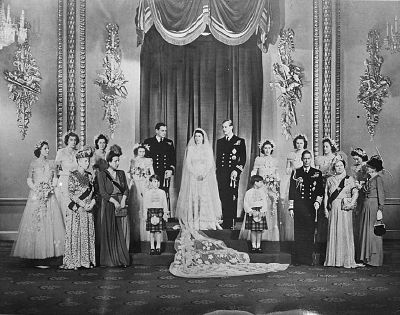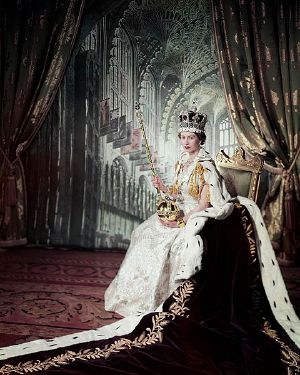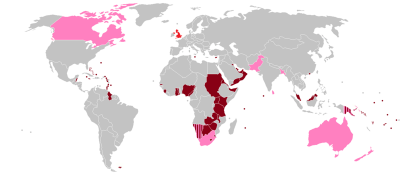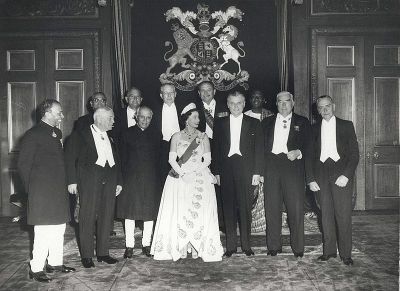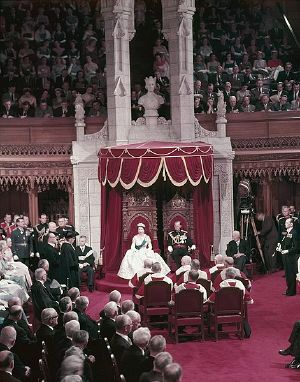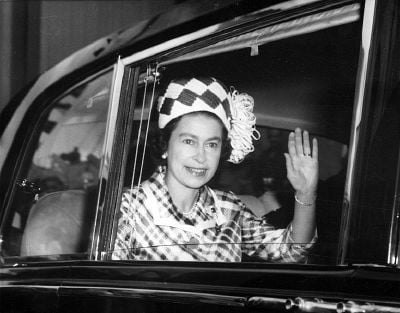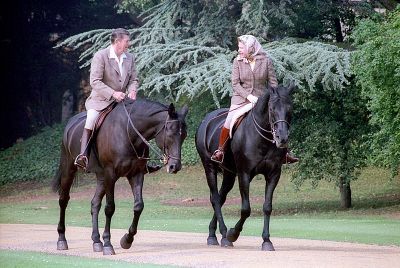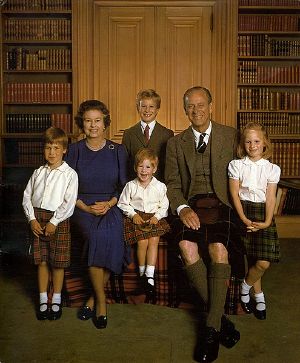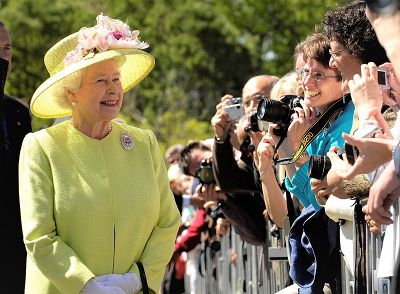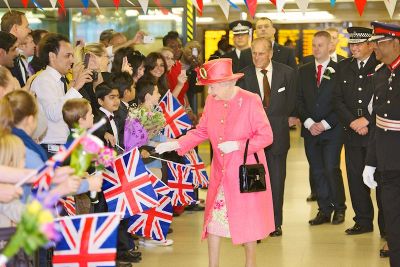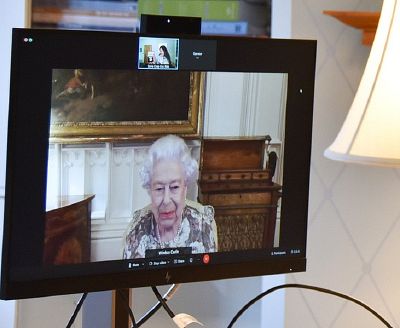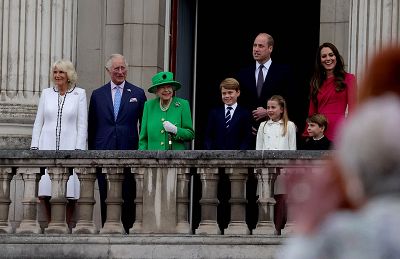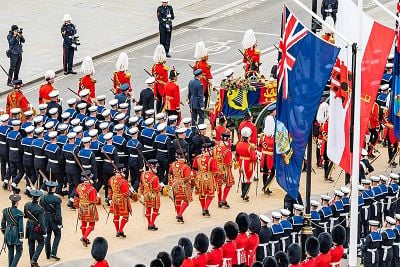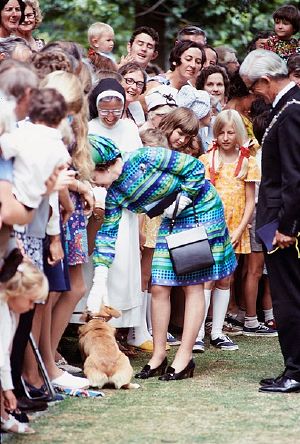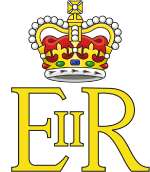Elizabeth II
| Elizabeth II | |
|---|---|
| Queen of the United Kingdom Head of the Commonwealth | |

| |
| Formal portrait, 1959 | |
| Reign | February 6, 1952 - September 8, 2022 |
| Coronation | June 2, 1953 |
| Predecessor | George VI |
| Successor | Charles III |
| Consort | Prince Philip, Duke of Edinburgh (m. 1947; died 2021) |
| Issue | |
| Charles III Anne, Princess Royal Prince Andrew, Duke of York Prince Edward, Duke of Edinburgh | |
| Full name | |
| Elizabeth Alexandra Mary | |
| Royal House | Windsor |
| Father | George VI |
| Mother | Elizabeth Bowes-Lyon |
| Born | April 21 1926 Mayfair, London, England |
| Died | September 8 2022 (aged 96) Balmoral Castle, Aberdeenshire, Scotland |
| Buried | September 19, 2022 King George VI Memorial Chapel, St George's Chapel, Windsor Castle |
Elizabeth II (Elizabeth Alexandra Mary; April 21, 1926 – September 8, 2022) was Queen of the United Kingdom and other Commonwealth realms from February 6, 1952 until her death in 2022. She was queen regnant of 32 sovereign states during her lifetime and was head of state of 15 realms at the time of her death. Her reign of 70 years and 214 days was the longest of any British monarch and the longest verified reign of any female head of state in history.
In November 1947, she married Philip Mountbatten, a former prince of Greece and Denmark, and their marriage lasted 73 years until his death in 2021. They had four children: Charles, Anne, Andrew, and Edward.
Elizabeth reigned as a constitutional monarch through major political changes, such as the Troubles in Northern Ireland, devolution in the United Kingdom, the decolonization of Africa, and the United Kingdom's accession to the European Communities and withdrawal from the European Union (Brexit), working with a total of 15 different Prime Ministers. Although she faced occasional republican sentiment and media criticism of her family—particularly after the breakdowns of her children's marriages, her annus horribilis in 1992, and the death in 1997 of her former daughter-in-law Diana—support for the monarchy in the United Kingdom remained consistently high throughout her lifetime, as did her personal popularity. Elizabeth died aged 96 at Balmoral Castle, Aberdeenshire, in Scotland in September 2022 and was succeeded by her eldest son, Charles III.
Early life
Elizabeth was born in Mayfair, London, on April 21, 1926 as the first child of the Duke and Duchess of York (later King George VI and Queen Elizabeth The Queen Mother). Her father was the second son of King George V and Queen Mary, and her mother was the youngest daughter of Scottish aristocrat Claude Bowes-Lyon, 14th Earl of Strathmore and Kinghorne. Her father acceded to the throne in 1936 upon the abdication of his brother Edward VIII, making the ten-year-old Princess Elizabeth the heir presumptive. Elizabeth's early life was spent primarily at her parents' residences at 145 Piccadilly (their town house in London) and Royal Lodge in Windsor.[1]
The Anglican Archbishop of York, Cosmo Gordon Lang, baptized her in the private chapel of Buckingham Palace on May 29. Her godparents were: King George V and Queen Mary; Lord Strathmore; Prince Arthur, Duke of Connaught and Strathearn (her paternal great-granduncle); Princess Mary, Viscountess Lascelles (her paternal aunt); and Lady Elphinstone (her maternal aunt).[2] She was named Elizabeth after her mother; Alexandra after her paternal great-grandmother, who had died six months earlier; and Mary after her paternal grandmother.[3] She was called "Lilibet" by her close family, based on what she called herself at first.[4] She was cherished by her grandfather George V, whom she affectionately called "Grandpa England."[5]
Elizabeth's only sibling, Princess Margaret, was born in 1930. The two princesses were educated at home under the supervision of their mother and their governess, Marion Crawford. Lessons concentrated on history, language, literature, and music. Crawford published a biography of Elizabeth and Margaret's childhood years entitled The Little Princesses in 1950,[1] much to the dismay of the royal family. The book describes Elizabeth's love of horses and dogs, her orderliness, and her attitude of responsibility. Others echoed such observations: Winston Churchill described Elizabeth when she was two as "a character. She has an air of authority and reflectiveness astonishing in an infant."[3] Her cousin Margaret Rhodes described her as "a jolly little girl, but fundamentally sensible and well-behaved."[3]
Heir presumptive

During her grandfather's reign, Elizabeth was third in the line of succession to the British throne, behind her uncle Edward and her father. Although her birth generated public interest, she was not expected to become queen, as Edward was still young and likely to marry and have children of his own, who would precede Elizabeth in the line of succession.[6] When her grandfather died in 1936 and her uncle succeeded as Edward VIII, she became second in line to the throne, after her father. Later that year, Edward abdicated, after his proposed marriage to divorced socialite Wallis Simpson provoked a constitutional crisis.[7] Consequently, Elizabeth's father became king, taking the regnal name George VI. Since Elizabeth had no brothers, she became heir presumptive. If her parents had subsequently had a son, he would have been heir apparent and above her in the line of succession, which was determined by the male-preference primogeniture in effect at the time.[8]
Elizabeth received private tuition in constitutional history from Henry Marten, Vice-Provost of Eton College.[9] She was also instructed in religion by the Archbishop of Canterbury and learned French from a succession of native-speaking governesses.[10] A Girl Guides company, the 1st Buckingham Palace Company, was formed specifically so she could socialize with girls her age.[8] Later, she was enrolled as a Sea Ranger.[10]
Second World War
In September 1939, Britain entered the Second World War. Lord Hailsham suggested that Princesses Elizabeth and Margaret should be evacuated to Canada to avoid the frequent aerial bombings of London by the Luftwaffe.[11] This was rejected by their mother, who declared, "The children won't go without me. I won't leave without the King. And the King will never leave."[12] The princesses stayed at Balmoral Castle, Scotland, until Christmas 1939, when they moved to Sandringham House, Norfolk. From February to May 1940, they lived at Royal Lodge, Windsor, until moving to Windsor Castle, where they lived for most of the next five years. At Windsor, the princesses staged pantomimes at Christmas in aid of the Queen's Wool Fund, which bought yarn to knit into military garments.[1]
In 1940, the 14-year-old Elizabeth made her first radio broadcast during the BBC's Children's Hour, addressing other children who had been evacuated from the cities:
We are trying to do all we can to help our gallant sailors, soldiers, and airmen, and we are trying, too, to bear our own share of the danger and sadness of war. We know, every one of us, that in the end all will be well.[13]
As she approached her 18th birthday, Parliament changed the law so that she could act as one of five counsellors of state in the event of her father's incapacity or absence abroad, such as his visit to Italy in July 1944.[5] In February 1945, she was appointed an honorary second subaltern in the Auxiliary Territorial Service. She trained and worked as a driver and mechanic and was given the rank of honorary junior commander (female equivalent of captain at the time) five months later.[14][15]
At the end of the war in Europe, on Victory in Europe Day, Elizabeth and Margaret mingled incognito with the celebrating crowds in the streets of London. Elizabeth later said in a rare interview with the BBC in 1985:
We cheered the king and the queen on the balcony and then walked miles through the streets. I remember lines of unknown people linking arms and walking down Whitehall, all of us just swept along on a tide of happiness and relief. I think it was one of the most memorable nights of my life.[16]
Elizabeth went on her first overseas tour in 1947, accompanying her parents through southern Africa. During the tour, in a broadcast to the British Commonwealth on her 21st birthday, she made the following pledge:
I declare before you all that my whole life, whether it be long or short, shall be devoted to your service and the service of our great imperial family to which we all belong.[17]
Marriage
Elizabeth met her future husband, Prince Philip of Greece and Denmark, in 1934 and again in 1937. They were second cousins once removed through King Christian IX of Denmark and third cousins through Queen Victoria. After meeting for the third time at the Royal Naval College in Dartmouth in July 1939, Elizabeth—though only 13 years old—said she fell in love with Philip, who was 18, and they began to exchange letters.[6] She was 21 when their engagement was officially announced on July 9, 1947.
The engagement attracted some controversy. Philip had no financial standing, was foreign-born (though a British subject who had served in the Royal Navy throughout the Second World War), and had sisters who had married German noblemen with Nazi links:
Some of the King's advisors did not think him good enough for her. He was a prince without a home or kingdom. Some of the papers played long and loud tunes on the string of Philip's foreign origin.[1]
Later biographies reported that Elizabeth's mother had reservations about the union initially and teased Philip as "the Hun".[18] In later life, however, she told the biographer Tim Heald that Philip was "an English gentleman."[19]
Before the marriage, Philip renounced his Greek and Danish titles, officially converted from Greek Orthodoxy to Anglicanism, and adopted the style Lieutenant Philip Mountbatten, taking the surname of his mother's British family. Shortly before the wedding, he was created Duke of Edinburgh and granted the style His Royal Highness. Elizabeth and Philip were married on November 20, 1947 at Westminster Abbey. They received 2,500 wedding gifts from around the world.[20] Elizabeth required ration coupons to buy the material for her wedding dress (which was designed by Norman Hartnell) because Britain had not yet completely recovered from the devastation of the war. In post-war Britain, it was not acceptable for Philip's German relations, including his three surviving sisters, to be invited to the wedding.[21] Neither was an invitation extended to the Duke of Windsor, formerly King Edward VIII.[22]
Elizabeth gave birth to her first child, Charles, in November 1948. One month earlier, the King had issued letters patent allowing her children to use the style and title of a royal prince or princess, to which they otherwise would not have been entitled as their father was no longer a royal prince.[5] A second child, Princess Anne, was born in August 1950.
Following their wedding, the couple leased Windlesham Moor, near Windsor Castle, until July 1949,[20] when they took up residence at Clarence House in London. At various times between 1949 and 1951, the Duke of Edinburgh was stationed in the British Crown Colony of Malta as a serving Royal Navy officer. He and Elizabeth lived intermittently in Malta for several months at a time in the hamlet of Gwardamanġa, at Villa Guardamangia, the rented home of Philip's uncle Lord Mountbatten. Their two children remained in Britain.
Reign
When her father died in February 1952, Elizabeth—then 25 years old—became queen of seven independent Commonwealth countries: the United Kingdom, Canada, Australia, New Zealand, South Africa, Pakistan, and Ceylon (known today as Sri Lanka), as well as head of the Commonwealth.
Accession and coronation
As George VI's health declined during 1951, Elizabeth frequently stood in for him at public events. When she visited Canada and Harry S. Truman in Washington, DC, in October 1951, her private secretary Martin Charteris carried a draft accession declaration in case the King died while she was on tour.[7] In early 1952, Elizabeth and Philip set out for a tour of Australia and New Zealand by way of the British colony of Kenya. On 6 February, they had just returned to their Kenyan home, Sagana Lodge, after a night spent at Treetops Hotel, when word arrived of the death of Elizabeth's father. Philip broke the news to the new queen.[9] She chose to retain Elizabeth as her regnal name,[23] and was therefore called Elizabeth II. The numeral offended some Scots, as she was the first Elizabeth to rule in Scotland.[24] She was proclaimed queen throughout her realms, and the royal party hastily returned to the United Kingdom. Elizabeth and Philip moved into Buckingham Palace.[5]
With Elizabeth's accession, it seemed possible that the royal house would take her husband's name, in line with the custom for married women of the time. Lord Mountbatten advocated for House of Mountbatten, and Philip suggested House of Edinburgh, after his ducal title. The British prime minister, Winston Churchill, and Elizabeth's grandmother Queen Mary favored the retention of the House of Windsor. Elizabeth issued a declaration on April 9, 1952 that the royal house would continue to be Windsor. Philip complained, "I am the only man in the country not allowed to give his name to his own children."[22] In 1960, the surname Mountbatten-Windsor was adopted for Philip and Elizabeth's male-line descendants who do not carry royal titles.
Amid preparations for the coronation, Princess Margaret told her sister she wished to marry Peter Townsend, a divorcé 16 years Margaret's senior with two sons from his previous marriage. Elizabeth asked them to wait for a year; in the words of her private secretary, "the Queen was naturally sympathetic towards the Princess, but I think she thought—she hoped—given time, the affair would peter out."[3] Senior politicians were against the match and the Church of England did not permit remarriage after divorce. If Margaret had contracted a civil marriage, she would have been expected to renounce her right of succession. Margaret decided to abandon her plans with Townsend. In 1960, she married Antony Armstrong-Jones, who was created Earl of Snowdon the following year. They were divorced in 1978. She did not remarry.[25]
Despite the death of Queen Mary on March 24, 1953, the coronation went ahead as planned on June 2, as Mary had requested.[22] On Elizabeth's instruction, her coronation gown was embroidered with the floral emblems of Commonwealth countries.[7] The coronation ceremony in Westminster Abbey was televised for the first time, with the exception of the anointing and communion.[26] Television coverage of the coronation was instrumental in boosting the medium's popularity; the number of television licenses in the United Kingdom doubled to 3 million, and many of the more than 20 million British viewers watched television for the first time in the homes of their friends or neighbors.[5]
Early years
From Elizabeth's birth onwards, the British Empire continued its transformation into the Commonwealth of Nations. By the time of her accession in 1952, her role as head of multiple independent states was already established. In 1953, Elizabeth and her husband embarked on a seven-month round-the-world tour, visiting 13 countries and covering more than 40,000 miles (64,000 km) by land, sea and air.[27] She became the first reigning monarch of Australia and New Zealand to visit those nations, although not the first member of the royal family.[28][29]
Throughout her reign, Elizabeth made hundreds of state visits to other countries and tours of the Commonwealth; she was the most widely traveled head of state.[30]
In 1956, the British and French prime ministers, Anthony Eden and Guy Mollet, discussed the possibility of France joining the Commonwealth. The proposal was never accepted, and the following year France signed the Treaty of Rome, which established the European Economic Community, the precursor to the European Union.[31] In November 1956, Britain and France invaded Egypt in an ultimately unsuccessful attempt to capture the Suez Canal. Eden resigned two months later.
The governing Conservative Party had no formal mechanism for choosing a leader, meaning that it fell to Elizabeth to decide whom to commission to form a government following Eden's resignation. Eden recommended she consult Lord Salisbury, the lord president of the council. Lord Salisbury and Lord Kilmuir, the lord chancellor, consulted the British Cabinet, Churchill, and the chairman of the backbench 1922 Committee, resulting in Elizabeth appointing their recommended candidate: Harold Macmillan.[32]
The Suez crisis and the choice of Eden's successor led, in 1957, to the first major personal criticism of Elizabeth. In a magazine, which he owned and edited, Lord Altrincham accused her of being "out of touch."[32] Altrincham was denounced by public figures and slapped by a member of the public appalled by his comments.[3] Six years later, in 1963, Macmillan resigned and advised Elizabeth to appoint Alec Douglas-Home as the prime minister, advice she followed. Elizabeth again came under criticism for appointing the prime minister on the advice of a small number of ministers or a single minister.[33] In 1965, the Conservatives adopted a formal mechanism for electing a leader, thus relieving the Queen of her involvement.[32]
In 1957, Elizabeth made a state visit to the United States, where she addressed the United Nations General Assembly on behalf of the Commonwealth. On the same tour, she opened the 23rd Canadian Parliament, becoming the first monarch of Canada to open a parliamentary session.[34] Two years later, solely in her capacity as Queen of Canada, she revisited the United States and toured Canada.[34] In 1961, she toured Cyprus, India, Pakistan, Nepal, and Iran. On a visit to Ghana the same year, she dismissed fears for her safety, even though her host, President Kwame Nkrumah, who had replaced her as head of state, was a target for assassins. Harold Macmillan wrote, "The Queen has been absolutely determined all through ... She is impatient of the attitude towards her to treat her as ... a film star ... She has indeed 'the heart and stomach of a man' ... She loves her duty and means to be a Queen."[35] Before her tour through parts of Quebec in 1964, the press reported extremists within the Quebec separatist movement were plotting Elizabeth's assassination. No attempt was made, but a riot did break out while she was in Montreal; Elizabeth's "calmness and courage in the face of the violence" was noted.[23]
Elizabeth gave birth to her third child, Prince Andrew, in February 1960, which was the first birth to a reigning British monarch since 1857. Her fourth child, Prince Edward, was born in March 1964.
On October 21, 1966, the Aberfan disaster in Wales saw 116 children and 28 adults killed when a colliery spoil tip collapsed, engulfing Pantglas Junior School and the surrounding houses in the village. The Queen was criticized for waiting eight days before deciding to visit the village, and her delay in visiting the scene was a mistake that she later regretted.[36]
1960s and 1970s
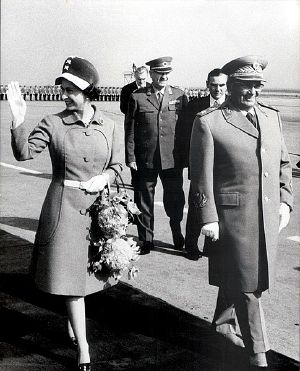
The 1960s and 1970s saw an acceleration in the decolonization of Africa and the Caribbean. More than 20 countries gained independence from Britain as part of a planned transition to self-government. In 1965, however, the Rhodesian prime minister, Ian Smith, in opposition to moves towards majority rule, unilaterally declared independence while expressing "loyalty and devotion" to Elizabeth, declaring her "Queen of Rhodesia." Although Elizabeth formally dismissed him, and the international community applied sanctions against Rhodesia, his regime survived for over a decade.[6] As Britain's ties to its former empire weakened, the British government sought entry to the European Community, a goal it achieved in 1973.
Elizabeth toured Yugoslavia in October 1972, becoming the first British monarch to visit a communist country. She was received at the airport by President Josip Broz Tito, and a crowd of thousands greeted her in Belgrade.[37]
In February 1974, the British prime minister, Edward Heath, advised Elizabeth to call a general election in the middle of her tour of the Austronesian Pacific Rim, requiring her to fly back to Britain. The election resulted in a hung parliament; Heath's Conservatives were not the largest party but could stay in office if they formed a coalition with the Liberals. When discussions on forming a coalition foundered, Heath resigned as prime minister, and Elizabeth asked the Leader of the Opposition, Labour's Harold Wilson, to form a government.[8]
A year later, at the height of the 1975 Australian constitutional crisis, the Australian prime minister, Gough Whitlam, was dismissed from his post by Governor-General Sir John Kerr, after the Opposition-controlled Senate rejected Whitlam's budget proposals. As Whitlam had a majority in the House of Representatives, Speaker Gordon Scholes appealed to Elizabeth to reverse Kerr's decision. She declined, saying she would not interfere in decisions reserved by the Constitution of Australia for the Governor-General.[5]
In 1977, Elizabeth marked the Silver Jubilee of her accession. Parties and events took place throughout the Commonwealth, many coinciding with her associated national and Commonwealth tours. The celebrations re-affirmed Elizabeth's popularity, despite virtually coincident negative press coverage of Princess Margaret's separation from her husband, Lord Snowdon. In 1978, Elizabeth endured a state visit to the United Kingdom by Romania's communist leader, Nicolae Ceaușescu, and his wife, Elena,[33] though privately she thought they had "blood on their hands."[9] The following year brought two blows: one was the unmasking of Anthony Blunt, former Surveyor of the Queen's Pictures, as a communist spy; the other was the assassination of her uncle-in-law Lord Mountbatten by the Provisional Irish Republican Army.
1980s
During the 1981 Trooping the Colour ceremony, six weeks before the wedding of Prince Charles and Lady Diana Spencer, six shots were fired at Elizabeth from close range as she rode down The Mall, London, on her horse, Burmese. Police later discovered the shots were blanks. The 17-year-old assailant, Marcus Sarjeant, was sentenced to five years in prison and released after three.[38] Elizabeth's composure and skill in controlling her mount were widely praised.[7]
That October, Elizabeth was the subject of another attack while on a visit to Dunedin, New Zealand. Christopher John Lewis, who was 17 years old, fired a shot with a .22 rifle from the fifth floor of a building overlooking the parade but missed.[39] Lewis was arrested, but instead of being charged with attempted murder or treason was sentenced to three years in jail for unlawful possession and discharge of a firearm. Two years into his sentence, he attempted to escape a psychiatric hospital with the intention of assassinating Prince Charles, who was visiting the country with Diana and their son Prince William.[40]
From April to September 1982, Elizabeth's son, Prince Andrew, served with British forces in the Falklands War, for which she reportedly felt anxiety and pride.[5] On July 9, she awoke in her bedroom at Buckingham Palace to find an intruder, Michael Fagan, in the room with her. In a serious lapse of security, assistance only arrived after two calls to the Palace police switchboard.[7] After hosting US president Ronald Reagan at Windsor Castle in 1982 and visiting his California ranch in 1983, Elizabeth was angered when his administration ordered the invasion of Grenada, one of her Caribbean realms, without informing her.[6]
Intense media interest in the opinions and private lives of the royal family during the 1980s led to a series of sensational stories in the press, pioneered by The Sun tabloid. As Kelvin MacKenzie, editor of The Sun, told his staff: "Give me a Sunday for Monday splash on the Royals. Don't worry if it's not true—so long as there's not too much of a fuss about it afterwards."[5] Newspaper editor Donald Trelford wrote in The Observer of September 21, 1986: "The royal soap opera has now reached such a pitch of public interest that the boundary between fact and fiction has been lost sight of ... it is not just that some papers don't check their facts or accept denials: they don't care if the stories are true or not."[9]
Brian Mulroney, Canadian prime minister between 1984 and 1993, said Elizabeth was a "behind the scenes force" in ending apartheid.[41] It was reported, most notably in The Sunday Times of July 20, 1986, that Elizabeth was worried that Margaret Thatcher's economic policies fostered social divisions and was alarmed by high unemployment, a series of riots, the violence of a miners' strike, and Thatcher's refusal to apply sanctions against the apartheid regime in South Africa. The sources of the rumors included royal aide Michael Shea and Commonwealth secretary-general Shridath Ramphal, but Shea claimed his remarks were taken out of context and embellished by speculation.[42] Reports of acrimony between them were exaggerated,[33] and Elizabeth gave two honors in her personal gift—membership in the Order of Merit and the Order of the Garter—to Thatcher after her replacement as prime minister by John Major.[32]
In 1986, Elizabeth paid a six-day state visit to the People's Republic of China, becoming the first British monarch to visit the country.[43] The tour included the Forbidden City, the Great Wall of China, and the Terracotta Warriors. At a state banquet, Elizabeth joked about the first British emissary to China being lost at sea with Queen Elizabeth I's letter to the Wanli Emperor, and remarked, "fortunately postal services have improved since 1602."[44] Elizabeth's visit also signified the acceptance of both countries that sovereignty over Hong Kong would be transferred from the United Kingdom to China in 1997.[45]
By the end of the 1980s, Elizabeth had become the target of satire. The involvement of younger members of the royal family in the charity game show It's a Royal Knockout in 1987 was ridiculed.[33] In Canada, Elizabeth publicly supported politically divisive constitutional amendments, prompting criticism from opponents of the proposed changes, including Pierre Trudeau. The same year, the elected Fijian government was deposed in a military coup. As monarch of Fiji, Elizabeth supported the attempts of Governor-General Ratu Sir Penaia Ganilau to assert executive power and negotiate a settlement. Coup leader Sitiveni Rabuka deposed Ganilau and declared Fiji a republic.[5]
1990s and Annus horribilis
In the wake of coalition victory in the Gulf War, Elizabeth became the first British monarch to address a joint meeting of the United States Congress in May 1991.
On November 24, 1992, in a speech to mark the Ruby Jubilee of her accession to the throne, Elizabeth called 1992 her annus horribilis (a Latin phrase, meaning "horrible year"). In an unusually personal speech, Elizabeth said that any institution must expect criticism, but suggested it might be done with "a touch of humour, gentleness and understanding."[46]
Two days later, British prime minister John Major announced plans to reform the royal finances, drawn up the previous year, including Elizabeth paying income tax from 1993 onwards, and a reduction in the civil list. [22] Republican feeling in Britain had risen because of press estimates of Elizabeth's private wealth, which were contradicted by the Palace. The Sunday Times Rich List 1989 put her number one on the list with a reported wealth of £5.2 billion, but it included state assets like the Royal Collection that were not hers personally.[47] In 1993, Buckingham Palace called estimates of £100 million "grossly overstated."[2] In 1971, Jock Colville, her former private secretary and a director of her bank, Coutts, estimated her wealth at £2 million.[5]
There were also reports of affairs and strained marriages among her extended family. In March, her second son, Prince Andrew, separated from his wife, Sarah, and Mauritius removed Elizabeth as head of state; her daughter, Princess Anne, divorced Captain Mark Phillips in April. In December, Prince Charles and his wife, Princess Diana, formally separated.
Angry demonstrators in Dresden threw eggs at Elizabeth during a state visit to Germany in October;[48] and a large fire broke out at Windsor Castle, one of her official residences, in November. At the end of the year, Elizabeth sued The Sun newspaper for breach of copyright when it published the text of her annual Christmas message two days before it was broadcast. The newspaper was forced to pay her legal fees and donated £200,000 to charity.[5]
In October 1994, she became the first reigning British monarch to set foot on Russian soil. The only previous state visit by a British monarch to Russia was made by King Edward VII in 1908. The King never stepped ashore, and met Nicholas II on royal yachts off the Baltic port of what is now Tallinn, Estonia.[49] During the four-day visit, which was considered to be one of the most important foreign trips of Elizabeth's reign, she and Philip attended events in Moscow and Saint Petersburg.[50]
In the year that followed, public revelations on the state of Charles and Diana's marriage continued. In consultation with her husband and John Major, as well as the Archbishop of Canterbury (George Carey) and her private secretary (Robert Fellowes), Elizabeth wrote to Charles and Diana at the end of December 1995, suggesting that a divorce would be advisable.[3]
In August 1997, a year after the divorce, Diana was killed in a car crash in Paris. Elizabeth was on holiday with her extended family at Balmoral. Diana's two sons, Princes William and Harry, wanted to attend church, so Elizabeth and Philip took them that morning. Afterwards, for five days, the royal couple shielded their grandsons from the intense press interest by keeping them at Balmoral where they could grieve in private, but the royal family's silence and seclusion, and the failure to fly a flag at half-mast over Buckingham Palace, caused public dismay.[6] Pressured by the hostile reaction, Elizabeth agreed to return to London and address the nation in a live television broadcast on 5 September, the day before Diana's funeral. In the broadcast, she expressed admiration for Diana and her feelings "as a grandmother" for the two princes. As a result, much of the public hostility evaporated.[6]
In October 1997, Elizabeth and Philip made a state visit to India, which included a controversial visit to the site of the Jallianwala Bagh massacre to pay her respects. Protesters chanted "Killer Queen, go back," and there were demands for her to apologize for the action of British troops 78 years earlier. At the memorial in the park, she and Philip laid a wreath and stood for a 30‑second moment of silence. As a result, much of the fury among the public softened, and the protests were called off.[51]
That November, Elizabeth and her husband held a reception at Banqueting House to mark their golden wedding anniversary. Elizabeth made a speech and praised Philip for his role as a consort, referring to him as "my strength and stay."[52]
In 1999, as part of the process of devolution within the UK, Elizabeth formally opened newly established legislatures for Wales and Scotland: the National Assembly for Wales at Cardiff in May,[53] and the Scottish Parliament at Edinburgh in July.[54]
New millennium and Golden Jubilee

On the eve of the new millennium, Elizabeth and Philip boarded a vessel from Southwark, bound for the Millennium Dome. Before passing under Tower Bridge, Elizabeth lit the National Millennium Beacon in the Pool of London using a laser torch.[55] Shortly before midnight, she officially opened the Dome. During the singing of Auld Lang Syne, Elizabeth held hands with Philip and British prime minister Tony Blair.[9]
In 2002, Elizabeth marked her Golden Jubilee, the 50th anniversary of her accession. Her sister and mother died in February and March, respectively, and the media speculated on whether the Jubilee would be a success or a failure. She again undertook an extensive tour of her realms, beginning in Jamaica in February, where she called the farewell banquet "memorable" after a power cut plunged King's House, the official residence of the governor-general, into darkness.[3] As in 1977, there were street parties and commemorative events, and monuments were named to honor the occasion. One million people attended each day of the three-day main Jubilee celebration in London, and the enthusiasm shown for Elizabeth by the public was greater than many journalists had anticipated.[6]
In November 2007, she became the first British monarch to celebrate a diamond wedding anniversary.[56] On March 20, 2008, at the Church of Ireland St Patrick's Cathedral, Armagh, Elizabeth attended the first Maundy service held outside England and Wales.[57]
Elizabeth addressed the UN General Assembly for a second time in 2010, again in her capacity as Queen of all Commonwealth realms and Head of the Commonwealth.[58] The UN secretary-general, Ban Ki-moon, introduced her as "an anchor for our age."[59] During her visit to New York, which followed a tour of Canada, she officially opened a memorial garden for British victims of the 9/11 attacks.[59] Elizabeth's 11-day visit to Australia in October 2011 was her 16th visit to the country since 1954.[60] In May 2011, by invitation of the Irish president, Mary McAleese, she made the first state visit to the Republic of Ireland by a British monarch.
Diamond Jubilee and longevity
Elizabeth's 2012 Diamond Jubilee marked 60 years on the throne, and celebrations were held throughout her realms, the wider Commonwealth, and beyond. She and her husband undertook an extensive tour of the United Kingdom, while her children and grandchildren embarked on royal tours of other Commonwealth states on her behalf. On June 4, Jubilee beacons were lit around the world.[61] On December 18, she became the first British sovereign to attend a peacetime Cabinet meeting since George III in 1781.
Elizabeth, who opened the 1976 Summer Olympics in Montreal, also opened the 2012 Summer Olympics and Paralympics in London, making her the first head of state to open two Olympic Games in two countries. For the London Olympics, she played herself in a short film as part of the opening ceremony, alongside Daniel Craig as James Bond.[62] </ref> On 4 April 2013, she received an honorary BAFTA for her patronage of the film industry and was called "the most memorable Bond girl yet" at the award ceremony.[63]

On March 3, 2013, Elizabeth stayed overnight at King Edward VII's Hospital as a precaution after developing symptoms of gastroenteritis. A week later, she signed the new Charter of the Commonwealth.[65] Because of her age and the need for her to limit traveling, in 2013 she chose not to attend the biennial Commonwealth Heads of Government Meeting for the first time in 40 years. She was represented at the summit in Sri Lanka by Prince Charles.[66] On April 20, 2018, the Commonwealth heads of government announced that Charles would succeed her as Head of the Commonwealth, which she stated was her "sincere wish."[67]
On December 21, 2007, Elizabeth surpassed her great-great-grandmother, Queen Victoria, and on September 9, 2015 to become the longest-lived British monarch, the longest-reigning British monarch, and the longest-reigning queen regnant and female head of state in the world. She became the oldest current monarch after King Abdullah of Saudi Arabia died on January 23, 2015. She later became the longest-reigning current monarch and the longest-serving current head of state following the death of King Bhumibol of Thailand on October 13, 2016, and the oldest current head of state on the resignation of Robert Mugabe of Zimbabwe on November 21, 2017.[68]
On February 6, 2017, she became the first British monarch to commemorate a sapphire jubilee, and on 20 November, she was the first British monarch to celebrate a platinum wedding anniversary.[69] Philip had retired from his official duties as the Queen's consort in August 2017.
COVID-19 pandemic
On March 19, 2020, as the COVID-19 pandemic hit the United Kingdom, Elizabeth moved to Windsor Castle and sequestered there as a precaution. Public engagements were cancelled and Windsor Castle followed a strict sanitary protocol nicknamed "HMS Bubble."[70]
On April 5, in a televised broadcast watched by an estimated 24 million viewers in the UK, she asked people to "take comfort that while we may have more still to endure, better days will return: we will be with our friends again; we will be with our families again; we will meet again."[71] On May 8, the 75th anniversary of VE Day, in a television broadcast at 9 pm—the exact time at which her father George VI had broadcast to the nation on the same day in 1945—she asked people to "never give up, never despair."[72]
Prince Philip died on April 9, 2021, after 73 years of marriage, making Elizabeth the first British monarch to reign as a widow or widower since Queen Victoria. She was at her husband's bedside when he died, and remarked in private that his death had "left a huge void."[73] Due to the COVID-19 restrictions in place in England at the time, Elizabeth sat alone at Philip's funeral service, which evoked sympathy from people around the world.[74] In her Christmas broadcast that year, which was ultimately her last, she paid a personal tribute to her "beloved Philip," saying, "That mischievous, inquiring twinkle was as bright at the end as when I first set eyes on him".[75]
Despite the pandemic, Elizabeth attended the 2021 State Opening of Parliament in May, and the 47th G7 summit in June. On July 5, the 73rd anniversary of the founding of the UK's National Health Service, she announced that the NHS would be awarded the George Cross to "recognise all NHS staff, past and present, across all disciplines and all four nations."[76]
Platinum Jubilee
Elizabeth's Platinum Jubilee began on February 6, 2022, marking 70 years since she acceded to the throne on her father's death. On the eve of the date, she held a reception at Sandringham House for pensioners, local Women's Institute members and charity volunteers. In her accession day message, Elizabeth renewed her commitment to a lifetime of public service, which she had originally made in 1947.[77]
Later that month, Elizabeth had "mild cold-like symptoms" and tested positive for COVID-19, along with some staff and family members. She held a phone conversation with British prime minister Boris Johnson amid a crisis on the Russo-Ukrainian border. Russia invaded Ukraine one day later, following which she made a donation to the Disasters Emergency Committee (DEC) Ukraine Humanitarian Appeal.[78] On February 28, she was reported to have recovered and spent time with her family at Frogmore. She later remarked that COVID infection "leave[s] one very tired and exhausted ... It's not a nice result."[79]
Elizabeth was present at the service of thanksgiving for Prince Philip at Westminster Abbey on March 29, but was unable to attend the annual Commonwealth Day service that month or the Royal Maundy service in April. She missed the State Opening of Parliament in May for the first time in 59 years. (She did not attend in 1959 and 1963 as she was pregnant with Prince Andrew and Prince Edward, respectively.)
During the Platinum Jubilee celebrations, Elizabeth was largely confined to balcony appearances and missed the National Service of Thanksgiving. For the Jubilee concert, she took part in a sketch with Paddington Bear, that opened the event outside Buckingham Palace.[80]
On June 13, she became the second-longest reigning monarch in history among those whose exact dates of reign are known, with 70 years, 127 days reigned—surpassing King Bhumibol Adulyadej of Thailand. On September 6, she appointed her 15th British prime minister, Liz Truss, at Balmoral Castle in Scotland.[81] This marked the only time she did not receive a new prime minister at Buckingham Palace during her reign. The Queen's last public message was issued on September 7, to her Canadian people, in the aftermath of the Saskatchewan stabbings.[82]
Death and Funeral
Queen Elizabeth II was in good health for most of her life; her health, however, declined significantly after the death of her husband, Prince Philip, in April 2021. She began to use a walking stick for public engagements in October 2021. She spent the summer of 2022 at Balmoral Castle in Scotland, where she was reported to have "found in the hills of this land, and the hearts of its people, a haven and a home."[83]
On September 8, 2022, Buckingham Palace released a statement that the Queen was under medical supervision as her doctors were concerned about her health. Her immediate family rushed to Balmoral to be by her side. She died peacefully at 15:10 BST at the age of 96, with two of her children, Charles and Anne, by her side.[84] Her death was announced to the public at 18:30, setting in motion Operation London Bridge and, because she died in Scotland, Operation Unicorn.[85] Elizabeth was the first monarch to die in Scotland since James V in 1542.[86] Her body was taken to Edinburgh, where ceremonies were held, then to London for the state funeral.
The Queen's coffin left Balmoral Castle on September 11, draped with the Scottish version of the Royal Standard of the United Kingdom and topped with a wreath of flowers from the castle gardens. The journey of the cortege, which included Princess Anne and Sir Timothy Laurence, was 175 miles (282 km) long and passed through Aberdeenshire, Aberdeen, Angus, Dundee, Perth and Kinross, and Fife. People lined the route of the cortege to pay their respects, and in Aberdeenshire farmers formed a guard of honor of tractors.[83] The cortege reached the Palace of Holyroodhouse in Edinburgh, and the coffin was placed in the Throne Room.
On September 12, Elizabeth's coffin was carried up the Royal Mile in a procession to St Giles' Cathedral, where the Crown of Scotland was placed on it.[87] Her coffin lay at rest at the cathedral for 24 hours, guarded by the Royal Company of Archers, during which thousands of people filed past to pay their respects.
On September 14, her coffin was taken in a military procession from Buckingham Palace to Westminster Hall, where Elizabeth lay in state for four days. The coffin was guarded by members of both the Sovereign's Bodyguard and the Household Division. Members of the public filed past the coffin, as did politicians and other public figures. On September 16, Elizabeth's children held a silent vigil around her coffin, and the next day her eight grandchildren did the same, as the members of the public continued to file past.[88]
Elizabeth's state funeral was held at Westminster Abbey on September 19, marking the first time that a monarch's funeral service had been held at the Abbey since George II in 1760. More than a million people lined the streets of central London, and the day was declared a holiday in several Commonwealth countries. In Windsor, a final procession involving 1,000 military personnel took place, which 97,000 people witnessed. Elizabeth's fell pony Emma, and two royal corgis, stood at the side of the procession.[89] After a committal service at St George's Chapel, Windsor Castle, Elizabeth was interred with her husband Philip in the King George VI Memorial Chapel later the same day, in a private ceremony attended by her closest family members.[90]
Legacy
Beliefs, activities, and interests
Elizabeth had a deep sense of religious and civic duty, and took her Coronation Oath seriously.[9] Following the Queen's death, the newly appointed Prime Minister, Liz Truss, said, "Her devotion to duty is an example to us all. Earlier this week, at 96, she remained determined to carry out her duties as she appointed me as her 15th Prime Minister."[81]
Elizabeth never planned to abdicate, though she took on fewer public engagements as she grew older and Prince Charles took on more of her duties.[8] The Queen told Canadian governor-general Adrienne Clarkson in a meeting in 2002 that she would never abdicate, saying "It is not our tradition. Although, I suppose if I became completely gaga, one would have to do something."[91]
In June 2022, Elizabeth met the Archbishop of Canterbury, Justin Welby, who "came away thinking there is someone who has no fear of death, has hope in the future, knows the rock on which she stands and that gives her strength."[92]
Aside from her official religious role as Supreme Governor of the established Church of England, she worshiped with that church and also the national Presbyterian Church of Scotland. She demonstrated support for inter-faith relations and met with leaders of other churches and religions, including five popes: Pius XII, John XXIII, John Paul II, Benedict XVI, and Francis.[93] A personal note about her faith often featured in her annual Christmas Message broadcast to the Commonwealth. In 2000, she said:
To many of us our beliefs are of fundamental importance. For me the teachings of Christ and my own personal accountability before God provide a framework in which I try to lead my life. I, like so many of you, have drawn great comfort in difficult times from Christ's words and example.[94]
She also had several meetings with the evangelist, Billy Graham, who was an ordained Southern Baptist minister. Although her official position prevented her from attending and endorsing his crusade meetings, she had Graham preach to the royal family at Windsor and Sandringham on several occasions. He was impressed by the Queen’s faith: “I always found her very interested in the Bible and its message.”[95]
Her main leisure interests included equestrianism and dogs, especially her Pembroke Welsh Corgis. Her lifelong love of corgis began in 1933 with Dookie, the first corgi owned by her family.[96]
Media depiction and public opinion
In the 1950s, as a young woman at the start of her reign, Elizabeth was depicted as a glamorous "fairytale Queen."[6] After the trauma of the Second World War, it was a time of hope, a period of progress and achievement heralding a "new Elizabethan age."[32] In the late 1960s, attempts to portray a more modern image of the monarchy were made in the television documentary Royal Family and by televising Prince Charles's investiture as Prince of Wales. Elizabeth also instituted other new practices; her first royal walkabout, meeting ordinary members of the public, took place during a tour of Australia and New Zealand in 1970.[33] Her wardrobe developed a recognizable, signature style driven more by function than fashion. In public, she took to wearing mostly solid-color overcoats and decorative hats, allowing her to be seen easily in a crowd.
At Elizabeth's Silver Jubilee in 1977, the crowds and celebrations were genuinely enthusiastic; but, in the 1980s, public criticism of the royal family increased, as the personal and working lives of Elizabeth's children came under media scrutiny. Her popularity sank to a low point in the 1990s. Under pressure from public opinion, she began to pay income tax for the first time, and Buckingham Palace was opened to the public. Although support for republicanism in Britain seemed higher than at any time in living memory, republican ideology was still a minority viewpoint, and Elizabeth herself had high approval ratings. Criticism was focused on the institution of the monarchy itself, and the conduct of Elizabeth's wider family, rather than her own behavior and actions. Discontent with the monarchy reached its peak on the death of Diana, Princess of Wales, although Elizabeth's personal popularity—as well as general support for the monarchy—rebounded after her live television broadcast to the world five days after Diana's death.
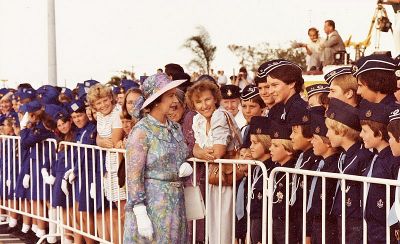
In November 1999, a referendum in Australia on the future of the Australian monarchy favored its retention in preference to an indirectly elected head of state. Many republicans credited Elizabeth's personal popularity with the survival of the monarchy in Australia. In 2010, Prime Minister Julia Gillard noted that there was a "deep affection" for Elizabeth in Australia and that another referendum on the monarchy should wait until after her reign. Gillard's successor, Malcolm Turnbull, who led the republican campaign in 1999, similarly believed that Australians would not vote to become a republic in her lifetime.[97] Similarly, referendums in both Tuvalu in 2008 and Saint Vincent and the Grenadines in 2009 saw voters reject proposals to become republics.
Polls in Britain in 2006 and 2007 revealed strong support for the Queen as monarch, and in 2012, Elizabeth's Diamond Jubilee year, her approval ratings hit 90 per cent.[98]
Her family came under scrutiny again in the last few years of her life due to her son Andrew's association with convicted sex offenders Jeffrey Epstein and Ghislaine Maxwell, his lawsuit with Virginia Giuffre amidst accusations of sexual impropriety, and her grandson Harry and his wife Meghan's exit from the working royal family and subsequent move to the United States. Polling in Great Britain during the Platinum Jubilee, however, showed support for maintaining the monarchy and Elizabeth's personal popularity remained strong. In 2021 she remained the third most admired woman in the world according to YouGov’s international survey, her 52 appearances on the list meaning she had been in the top ten more than any other woman in the poll's history.[99]
Elizabeth was portrayed in a variety of media by many notable artists, including painters Pietro Annigoni, Peter Blake, Chinwe Chukwuogo-Roy, Terence Cuneo, Lucian Freud, Rolf Harris, Damien Hirst, Juliet Pannett, and Tai-Shan Schierenberg. Notable photographers of Elizabeth included Cecil Beaton, Yousuf Karsh, Anwar Hussein, Annie Leibovitz, Lord Lichfield, Terry O'Neill, John Swannell and Dorothy Wilding. The first official portrait photograph of Elizabeth was taken by Marcus Adams in 1926.[100]
Titles, styles, and arms
Titles and styles
Elizabeth held many titles and honorary military positions throughout the Commonwealth, was sovereign of many orders in her own countries and received honors and awards from around the world. In each of her realms, she had a distinct title that follows a similar formula: Queen of Saint Lucia and of Her other Realms and Territories in Saint Lucia, Queen of Australia and Her other Realms and Territories in Australia, etc. In the Channel Islands and Isle of Man, which are Crown Dependencies rather than separate realms, she was known as Duke of Normandy and Lord of Mann, respectively. Additional styles include Defender of the Faith and Duke of Lancaster.
Arms
From April 21, 1944 until her accession, Elizabeth's arms consisted of a lozenge bearing the royal coat of arms of the United Kingdom differenced with a label of three points argent, the center point bearing a Tudor rose and the first and third a cross of St George.
Upon her accession, she inherited the various arms her father held as sovereign. Elizabeth also possessed royal standards and personal flags for use in the United Kingdom, Canada, Australia, New Zealand, Jamaica, and elsewhere.[101]
Notes
- ↑ 1.0 1.1 1.2 1.3 Marion Crawford, The Little Princesses: The Story of the Queen's Childhood by Her Nanny, Marion Crawford (St. Martin's Griffin, 2020 (original 1950), ISBN 978-1250765758).
- ↑ 2.0 2.1 Brian Hoey, Her Majesty: 50 Regal Years (Harpercollins Pub Ltd, 2002, ISBN 978-0006531364).
- ↑ 3.0 3.1 3.2 3.3 3.4 3.5 3.6 Gyles Brandreth, Philip and Elizabeth: Portrait of a Royal Marriage (W. W. Norton, 2005, ISBN 978-0393061130).
- ↑ David Williamson, Debrett's Kings and Queens of Britain (Harpercollins, 1986, ISBN 978-0863501012)
- ↑ 5.00 5.01 5.02 5.03 5.04 5.05 5.06 5.07 5.08 5.09 5.10 Ben Pimlott, The Queen: Elizabeth II and the Monarchy (HarperCollins, 2001, ISBN 978-0007114351).
- ↑ 6.0 6.1 6.2 6.3 6.4 6.5 6.6 6.7 Jennie Bond, Elizabeth: 80 Glorious Years (Carlton Books, 2006, ISBN 978-1844422609).
- ↑ 7.0 7.1 7.2 7.3 7.4 Robert Lacey, Royal: Her Majesty Queen Elizabeth II (Little, Brown, 2002, ISBN 0316859400).
- ↑ 8.0 8.1 8.2 8.3 Andrew Marr, The Diamond Queen: Elizabeth II and Her People (MacMillan, 2012, ISBN 978-0230748521).
- ↑ 9.0 9.1 9.2 9.3 9.4 9.5 William Shawcross, Queen and Country (McClelland & Stewart, 2002, ISBN 978-0771080562).
- ↑ 10.0 10.1 Her Majesty The Queen: Early life and education The Royal Household. Retrieved July 28, 2023.
- ↑ Christopher Warwick, Princess Margaret: A Life of Contrasts (Andre Deutsch Ltd, 2003, ISBN 978-0233051062).
- ↑ Queen Elizabeth The Queen Mother The Royal Household. Retrieved July 29, 2023.
- ↑ Children's Hour: Princess Elizabeth BBC Archive (October 13, 1940). Retrieved July 29, 2023.
- ↑ Lily Rothman, The World War II Auto Mechanic in This Photo Is Queen Elizabeth II. Here's the Story Behind the Picture TIME (May 25, 2018). Retrieved July 29, 2023.
- ↑ Sabrina Barr, Our Queen at War: Princess Elizabeth’s role in the British armed forces during the Second World War The Independent (April 22, 2020). Retrieved July 29, 2023.
- ↑ Hayley Peppin, The 17 most memorable quotes the Queen shared throughout her 70-year reign Harpers Bazaar. Retrieved July 29, 2023
- ↑ A speech by the Queen on her 21st Birthday, 1947 The Royal Household. Retrieved July 29, 2023.
- ↑ Caroline Davies, Philip, the one constant through her life The Daily Telegraph (April 20, 2006). Retrieved July 29, 2023.
- ↑ Tim Heald, Princess Margaret: A Life Unravelled (Orion Publishing, 2007, ISBN 978-0297848202).
- ↑ 20.0 20.1 Wedding Gifts of Queen Elizabeth II The Royal Watcher (November 12, 2022). Retrieved August 1, 2023.
- ↑ Jonathan Petropoulos, Royals and the Reich: The Princes von Hessen in Nazi Germany (Oxford University Press, 2006, ISBN 978-0195161335).
- ↑ 22.0 22.1 22.2 22.3 Sarah Bradford, Queen Elizabeth II: Her Life In Our Times (Viking, 2012, ISBN 978-0670919116).
- ↑ 23.0 23.1 Arthur Bousfield and Garry Toffoli, Fifty Years the Queen: A Tribute to Elizabeth II on Her Golden Jubilee (Dundurn, 2002, ISBN 978-1550023602).
- ↑ James Mitchell, "Scotland: Cultural Base and Economic Catalysts" in Jonathan Hollowell (ed.), Britain Since 1945 (Wiley-Blackwell, 2002, ISBN 978-0631209683), 109–125.
- ↑ Princess Margaret: Marriage and family The Royal Household. Retrieved August 1, 2023.
- ↑ 50 facts about The Queen's Coronation The Royal Household. Retrieved August 1, 2023.
- ↑ The Commonwealth: Gifts to the Queen Royal Collection Trust. Retrieved August 2, 2023.
- ↑ The 1954 Royal Tour of Queen Elizabeth II State Library New South Wales. Retrieved August 2, 2023.
- ↑ New Zealand: Royal Visits The Royal Household. Retrieved August 2, 2023.
- ↑ Sophie Campbell, Queen's Diamond Jubilee: Sixty years of royal tours The Daily Telegraph (May 11, 2012). Retrieved August 2, 2023.
- ↑ Mike Thomson, When Britain and France nearly married BBC News (January 15, 2007). Retrieved August 3, 2023.
- ↑ 32.0 32.1 32.2 32.3 32.4 Andrew Roberts, Antonia Fraser (ed.), The House of Windsor (University of California Press, 2000, ISBN 0520228030).
- ↑ 33.0 33.1 33.2 33.3 33.4 Robert Hardman, Our Queen (Hutchinson, 2011, ISBN 978-0091936891).
- ↑ 34.0 34.1 Highlights of Queen Elizabeth II’s royal tours of Canada Canadian Geographic (September 8, 2022). Retrieved August 4, 2023.
- ↑ Harold Macmillan, Pointing the way, 1959-1961 (Macmillan, 1972, ISBN 978-0333124116).
- ↑ Aberfan disaster: The Queen's regret after tragedy BBC News (September 11, 2022). Retrieved August 4, 2023.
- ↑ Big Crowds in Belgrade Greet Queen Elizabeth The New York Times (October 18, 1972). Retrieved August 5, 2023.
- ↑ Queen's 'fantasy assassin' jailed BBC News (September 14, 1981). Retrieved August 5, 2023.
- ↑ Hamish McNeilly, Intelligence documents confirm assassination attempt on Queen Elizabeth in New Zealand The Sydney Morning Herald (March 1, 2018). Retrieved August 5, 2023.
- ↑ Eleanor Ainge Roy, 'Damn ... I missed': the incredible story of the day the Queen was nearly shot The Guardian (January 13, 2018). Retrieved August 5, 2023.
- ↑ Michael Taube, What Queen Elizabeth II meant to Canada Troy Media (September 13, 2022). Retrieved August 7, 2023.
- ↑ Andrew Neil, Full Disclosure (Pan Macmillan, 1996, ISBN 978-0333646823).
- ↑ Queen fulfills a Royal Goal: To visit China The New York Times (October 13, 1986). Retrieved August 7, 2023.
- ↑ Robert Hardman, Queen of the World (Century, 2018, ISBN 978-1780898186).
- ↑ Carroll R. Bogert, Queen Elizabeth II Arrives In Peking for 6-Day Visit The Washington Post (October 13, 1986). Retrieved August 7, 2023.
- ↑ Connie Fisher, Annus horribilis speech The Royal Household (November 24, 1992). Retrieved August 7, 2023.
- ↑ Anthony Reuben, Rich List: Changing face of wealth BBC News (April 18, 2013). Retrieved August 7, 2023.
- ↑ Douglas Stanglin, German study concludes 25,000 died in Allied bombing of Dresden USA Today (March 18, 2010). Retrieved August 7, 2023.
- ↑ Fiona K. Tomaszewski, A Great Russia: Russia and the Triple Entente, 1905 to 1914 (Praeger, 2002, ISBN 978-0275973667).
- ↑ British queen in Moscow United Press International (October 17, 1994). Retrieved August 7, 2023.
- ↑ Indian group calls off protest, accepts queen's regrets CNN (October 14, 1997). Retrieved August 7, 2023.
- ↑ Connie Fisher, A speech by The Queen on her Golden Wedding Anniversary The Royal Household (November 20, 1997). Retrieved August 7, 2023.
- ↑ Geoffrey Gibbs, Welsh crown day with a song The Guardian (May 27, 1999). Retrieved August 7, 2023.
- ↑ Matthew Engel, Something for everyone as Scots at last put history behind them The Guardian (July 1, 1999). Retrieved August 7, 2023.
- ↑ Beacons blaze across UK BBC News (December 31, 1999). Retrieved August 8, 2023.
- ↑ Queen celebrates diamond wedding BBC News (November 19, 2007). Retrieved August 8, 2023.
- ↑ Historic first for Maundy service BBC News (March 20, 2008). Retrieved August 8, 2023.
- ↑ Ciara Berry, A speech by the Queen to the United Nations General Assembly The Royal Household (July 6, 2010). Retrieved August 8, 2023.
- ↑ 59.0 59.1 Queen addresses UN General Assembly in New York BBC News (July 7, 2010). Retrieved August 8, 2023.
- ↑ Queen And Prince Philip End Tour With Aussie Barbie Huff Post (December 29, 2011). Retrieved August 8, 2023.
- ↑ Martin Wainwright, Queen's diamond jubilee beacons light up the world The Guardian (June 4, 2012). Retrieved August 8, 2023.
- ↑ Nicolas Brown, How James Bond whisked the Queen to the Olympics BBC News (July 27, 2012). Retrieved August 8, 2023.
- ↑ Queen honoured with Bafta award for film and TV support BBC News (April 4, 2013). Retrieved August 8, 2023.
- ↑ Ciara Berry, A speech by The Queen at the Borders Railway, Scotland The Royal Household (September 9, 2015). Retrieved August 8, 2023.
- ↑ Recovering Queen signs Commonwealth charter BBC News (March 11, 2013). Retrieved August 8, 2023.
- ↑ Queen to miss Commonwealth meeting BBC News (May 7, 2013). Retrieved August 8, 2023.
- ↑ Charles to be next Commonwealth head BBC News (April 20, 2018). Retrieved August 8, 2023.
- ↑ Robert Hart, Elizabeth II Wasn't Just The World's Longest-Reigning Queen—Here Are The Other Big Records She Broke Forbes (September 9, 2022). Retrieved August 8, 2023.
- ↑ Press Association, Queen and Prince Philip portraits released to mark 70th anniversary The Guardian (November 20, 2017). Retrieved August 9, 2023.
- ↑ Coronavirus: Queen and Prince Philip return to Windsor Castle for lockdown Sky News (November 2, 2020). Retrieved August 9, 2023.
- ↑ Coronavirus: The Queen's broadcast in full BBC News (April 5, 2020). Retrieved August 9, 2023.
- ↑ VE Day: UK's streets not empty as filled with love, says Queen BBC News (May 8, 2020). Retrieved August 9, 2023.
- ↑ Prince Philip: The Queen says his death has 'left a huge void' - Duke of York BBC News (April 11, 2021). Retrieved August 9, 2023.
- ↑ Jennifer Hassan, Image of Queen Elizabeth II sitting alone at Philip’s funeral breaks hearts around the world The Washington Post (April 17, 2021). Retrieved August 9, 2023.
- ↑ Sean Coughlan, Queen's Christmas message pays tribute to 'beloved' Philip BBC News (December 25, 2021). Retrieved August 9, 2023.
- ↑ Queen gives George Cross to NHS for staff's 'courage and dedication' BBC News (July 5, 2021). Retrieved August 9, 2023.
- ↑ Emma Goodey, Accession Day 2022 The Royal Household (February 2022). Retrieved August 9, 2023.
- ↑ Hannah Furness, The Queen makes 'generous' private donation to Ukraine fund as Royal family shows its support The Daily Telegraph (March 3, 2022). Retrieved August 9, 2023.
- ↑ Jenn Selby, Covid left me 'exhausted', Queen tells bereaved couple The Guardian (April 10, 2022). Retrieved August 9, 2023.
- ↑ Ma'amalade sandwich Your Majesty? YouTube. Retrieved August 9, 2023.
- ↑ 81.0 81.1 Chloe Foussianes, Queen Elizabeth Worked With 15 Prime Ministers During Her Reign. Here She Is With All of Them Town & Country (November 9, 2022). Retrieved August 15, 2023.
- ↑ In last public statement, Queen Elizabeth extended condolences following Saskatchewan stabbing rampage Saskatoon StarPhoenix (September 8, 2022). Retrieved August 9, 2023.
- ↑ 83.0 83.1 Jeremy Watson, Farmers show their love with a tractor guard of honour The Times (September 12, 2023.
- ↑ Jonathan Prynn, Queen died ‘with Charles and Anne by side as other royals dashed to Balmoral’ Evening Standard (September 9, 2022). Retrieved August 11, 2023.
- ↑ Caroline Davies, Operation Unicorn: what happens after the Queen's death in Scotland? The Guardian (September 8, 2023). Retrieved August 11, 2023.
- ↑ Christopher Silver, Elizabeth, the last Queen of Scots? Prospect (September 13, 2022). Retrieved August 11, 2023.
- ↑ Allan Little, The quiet symbolism of the Queen's farewell to Scotland BBC News (September 13, 2022). Retrieved August 11, 2023.
- ↑ Alex Therrien, Royals hold sombre watch over Queen's coffin BBC News (September 17, 2022). Retrieved August 11, 2023.
- ↑ Claire Heald, Queen's corgis and pony wait at Windsor Castle as coffin approaches BBC News (September 19, 2022). Retrieved August 11, 2023.
- ↑ Your complete guide to the Queen's funeral BBC News (September 19, 2022). Retrieved August 11, 2023.
- ↑ John Paul Tasker, Canada is the country it is today because of Queen Elizabeth, Mulroney says at memorial service CBC News (September 19, 2022). Retrieved August 9, 2023.
- ↑ Harriet Sherwood, Queen had no fear of death, says archbishop of Canterbury The Guardian (September 9, 2022). Retrieved August 9, 2023.
- ↑ Queen meets Pope Francis at the Vatican BBC News (April 3, 2014). Retrieved August 12, 2023.
- ↑ Connie Fisher, Christmas Broadcast 2000 The Royal Household (December 25, 2000). Retrieved August 12, 2023.
- ↑ Billy Graham and Queen Elizabeth II The Billy Graham Library (September 13, 2022). Retrieved August 12, 2023.
- ↑ Andrew Pierce, Hug for Queen Elizabeth's first corgi The Telegraph (October 1, 2007). Retrieved August 12, 2023.
- ↑ Judith Ireland, We're all Elizabethans now: When Malcolm Turnbull met the monarch The Sydney Morning Herald (July 15, 2017). Retrieved August 9, 2023.
- ↑ Monarchy/Royal Family Trends – Satisfaction with the Queen Ipsos (May 17, 2022). Retrieved August 9, 2023.
- ↑ Matthew Smith, World's most admired 2021 YouGov (December 13, 2021). Retrieved August 9, 2023.
- ↑ Marcus Adams (1875-1959), Photographer National Portrait Gallery. Retrieved August 9, 2023.
- ↑ Ciara Berry, Personal flags The Royal Household. Retrieved August 9, 2023.
ReferencesISBN links support NWE through referral fees
- Bond, Jennie. Elizabeth: 80 Glorious Years. Carlton Books, 2006. ISBN 978-1844422609
- Bousfield, Arthur, and Garry Toffoli. Fifty Years the Queen: A Tribute to Elizabeth II on Her Golden Jubilee. Dundurn, 2002. ISBN 978-1550023602
- Bradford, Sarah. Queen Elizabeth II: Her Life In Our Times. Viking, 2012. ISBN 978-0670919116
- Brandreth, Gyles. Philip and Elizabeth: Portrait of a Royal Marriage. W. W. Norton, 2005. ISBN 978-0393061130
- Crawford, Marion. The Little Princesses: The Story of the Queen's Childhood by Her Nanny, Marion Crawford. St. Martin's Griffin, 2020 (original 1950). ISBN 978-1250765758
- Hardman, Robert. Our Queen. Hutchinson, 2011. ISBN 978-0091936891
- Hardman, Robert. Queen of the World. Century, 2018. ISBN 978-1780898186
- Heald, Tim. Princess Margaret: A Life Unravelled. Orion Publishing, 2007. ISBN 978-0297848202
- Hoey, Brian. Her Majesty: 50 Regal Years. Harpercollins Pub Ltd, 2002. ISBN 978-0006531364
- Hollowell,Jonathan (ed.). Britain Since 1945. Wiley-Blackwell, 2002. ISBN 978-0631209683
- Lacey, Robert. Royal : Her Majesty Queen Elizabeth II. Little, Brown, 2002. ISBN 0316859400
- Macmillan, Harold. Pointing the way, 1959-1961. Macmillan, 1972. ISBN 978-0333124116
- Marr, Andrew. The Diamond Queen: Elizabeth II and Her People. MacMillan, 2012. ISBN 978-0230748521
- Neil, Andrew. Full Disclosure. Pan Macmillan, 1996. ISBN 978-0333646823
- Petropoulos, Jonathan. Royals and the Reich: The Princes von Hessen in Nazi Germany. Oxford University Press, 2006. ISBN 978-0195161335
- Pimlott, Ben. The Queen: Elizabeth II and the Monarchy. HarperCollins, 2001. ISBN 978-0007114351
- Roberts, Andrew, Antonia Fraser (ed.). The House of Windsor. University of California Press, 2000. ISBN 0520228030
- Shawcross, William. Queen and Country. McClelland & Stewart, 2002. ISBN 978-0771080562
- Tomaszewski, Fiona K. A Great Russia: Russia and the Triple Entente, 1905 to 1914. Praeger, 2002., ISBN 978-0275973667
- Warwick, Christopher. Princess Margaret: A Life of Contrasts. Andre Deutsch Ltd, 2003. ISBN 978-0233051062
- Williamson, David. Debrett's Kings and Queens of Britain. Harpercollins, 1986. ISBN 978-0863501012
External links
All links retrieved February 13, 2024.
- Queen Elizabeth II The Royal Household
- Queen Elizabeth II Government of Canada
- Queen Elizabeth II, Queen of the United Kingdom (1926-2022) Royal Collection Trust
- Queen Elizabeth II (1926-2022), Reigned 1952-2022 National Portrait Gallery
- Billy Graham and Queen Elizabeth II The Billy Graham Library
Credits
New World Encyclopedia writers and editors rewrote and completed the Wikipedia article in accordance with New World Encyclopedia standards. This article abides by terms of the Creative Commons CC-by-sa 3.0 License (CC-by-sa), which may be used and disseminated with proper attribution. Credit is due under the terms of this license that can reference both the New World Encyclopedia contributors and the selfless volunteer contributors of the Wikimedia Foundation. To cite this article click here for a list of acceptable citing formats.The history of earlier contributions by wikipedians is accessible to researchers here:
The history of this article since it was imported to New World Encyclopedia:
Note: Some restrictions may apply to use of individual images which are separately licensed.
